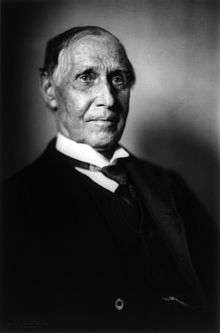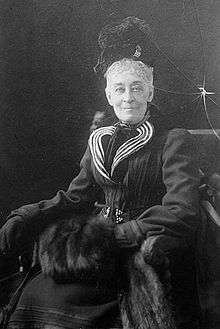Russell Sage
| Russell Sage | |
|---|---|
 Russell Sage in 1903. | |
| Member of the U.S. House of Representatives from New York's 13th district | |
|
In office March 4, 1853 – March 3, 1857 | |
| Preceded by | John L. Schoolcraft |
| Succeeded by | Abram B. Olin |
| Member of the Troy City Council | |
|
In office 1841–1848 | |
| Personal details | |
| Born |
April 4, 1816 Verona, New York, U.S. |
| Died |
July 22, 1906 (aged 90) New York City, New York, U.S |
| Resting place | Oakwood Cemetery, Troy, New York |
| Nationality | American |
| Political party |
Whig (1841–1854) Opposition (1854–1858) |
| Spouse(s) |
Marie-Henrie Winne (m. 1840; her death 1867) Olivia Slocum (m. 1868; his death 1906) |
| Children | 1 illegitimate child |
| Profession | Businessman, socialite |
| Religion | Presbyterianism |
| Net worth | US $70 million (1906) |
Russell Sage (August 4, 1816 – July 22, 1906) was a financier, railroad executive and Whig politician from New York, United States. As a frequent partner of Jay Gould in various transactions, he amassed a fortune. Olivia Slocum Sage, his second wife, inherited his fortune, which was unrestricted for her use. In his name she used the money for philanthropic purposes, endowing a number of buildings and institutions to benefit women's education: she established the Russell Sage Foundation in 1907 and founded the Russell Sage College for women in 1916.
Early life and family
Sage was born at Verona in Oneida County, New York. He received a public school education and worked as a farm hand until he was 15. He started as an errand boy in his brother Henry's grocery in Troy, New York. He had a part interest in 1837–1839 in a retail grocery in Troy, and in a wholesale store there in 1839–1857.
On January 23, 1840, Sage married Marie-Henrie Winne, who was also known as "Maria Winne". They had no children. She died on May 7, 1867, of stomach cancer. In 1869 at the age of 53, Sage remarried, to Olivia Slocum (1828–1918), who was ten years younger.
Political career
In 1841 Sage was elected as alderman in Troy. He was re-elected to this office until 1848, while also serving for seven years as treasurer of Rensselaer County. He was elected to the U.S. House of Representatives as a Whig, and served, with re-election as an Oppositionist, from 4 March 1853 until 3 March 1857. He served on the Ways and Means Committee. Sage was the first person to advocate in Congress for the purchase of George Washington's plantation, Mount Vernon, by the government.
Subsequently, Sage settled in New York City, and engaged in the business of selling puts and calls and privileges[1] on Wall Street.

In 1869, Sage was involved in a legal case concerning the usury laws in New York state, in which he was accused of being the leader of a usury group. He was convicted and fined $500, but his jail sentence was suspended. That year he remarried, to Olivia Slocum of Syracuse, New York.
Financial career
Sage bought a seat on the New York Stock Exchange in 1874, and became known as a financier. At the same time he saw the future of railroads, and secured stocks in western roads, notably the Chicago, Milwaukee and St. Paul Railway. He was president and vice-president for twelve years. By selling such investments, as the smaller roads were bought by major trunk-lines, he became wealthy.
In his later years Sage was closely associated with Jay Gould in the management of the Wabash Railway, St. Louis and Pacific, Missouri Pacific Railroad, Missouri-Kansas-Texas Railroad, Delaware, Lackawanna and Western Railroad and the St. Louis - San Francisco Railway, for which he was director of the corporations. He also served as director for the American cable company, the Western Union telegraph company, and the Manhattan consolidated system of elevated railroads in New York City.
Sage was also a director of the Union Pacific Railroad, which was part of constructing the transcontinental railroad. Together with other major investors (and railroad robber barons of the nineteenth century), he made a fortune. He was a director and vice-president in the Importers and Traders' National Bank for twenty years, and also a director in the Merchants' Trust Company and in the Fifth Avenue Bank of New York City.
Assassination attempt
In 1891, Henry L. Norcross entered the office of Sage at 71 Broadway in Manhattan, claiming he needed to discuss railroad bonds. Norcross gave Sage a letter demanding $1,200,000, which Sage declined to pay. Norcross was carrying a bag of dynamite, which exploded, killing Norcross, wounding Sage, and severely wounding William R. Laidlaw, Jr., a clerk for John Bloodgood and Co. who happened to be in the office. Afterward Laidlaw sued Sage, alleging that he had used him as a shield against Norcross. Disabled for life, Laidlaw aggressively pursued the lawsuits, winning $43,000 in damages after four trials, but a Court of Appeals reversed the award. Sage never paid any settlement and was publicly criticized as a miser because of his great fortune.
Personal life
Sage was known to have affairs outside marriage both before and after the death of his first wife. The writer Paul Sarnoff suggested in his biography of Sage that he may have remarried for appearance's sake, and may never have consummated his second marriage.[2] Sage was reported to have had a child by a young chambermaid.[2]
Sage was a member of West Presbyterian Church on West 42nd Street between Fifth and Sixth Avenue, which later merged with Park Presbyterian to form West-Park Presbyterian.[3]
In 1906 Sage died and left his entire fortune of about $70 million to his wife, Olivia Slocum Sage (1828–1918). He was buried in a mausoleum in Oakwood Cemetery in Troy, New York. The mausoleum is of a Greek style and is intentionally unnamed. To the left of the memorial is a bench which contains a relief of Medusa on the center of the back, complete with snakes as hair.[4]
Legacy and honors
Olivia Sage devoted a major portion of the money she inherited from her husband to philanthropy, including buildings and other memorials to him. She commissioned Ralph Adams Cram, a leading architect, to design Russell Sage Memorial Church, and for Louis Tiffany to create a large stained glass window as a memorial.[5] Built in 1908, the church was located in Far Rockaway, Queens, where the family had a summer home.
In 1907 she established the Russell Sage Foundation, and in 1916 founded Russell Sage College in Troy. In addition she gave extensively to the Emma Willard School and to Rensselaer Polytechnic Institute (RPI) in Troy, her husband's home town.[6]
References
Notes
- ↑ Privileges were options sold over the counter in nineteenth-century United States, with both puts and calls on shares offered by specialized dealers. Their exercise price was fixed at a rounded-off market price on the day or week that the option was bought, and the expiry date was generally three months after purchase. They were not traded in secondary markets.
- 1 2 Sarnoff (1965)
- ↑ Presa, Donald G. (January 12, 2010) "West Park Presbyterian Church Designation Report" New York City Landmarks Preservation Commission
- ↑ "Oakwood Cemetery: History". Troy Cemetery Association. Retrieved 2009-10-09.
- ↑ Merrill Hesch (July 1986). "National Register of Historic Places Registration: Russell Sage Memorial Church / First Presbyterian Church of Far Rockaway". New York State Office of Parks, Recreation and Historic Preservation. Retrieved 2008-10-03.
- ↑ Of the two buildings named "Russell Sage" at RPI, the Russell Sage Dining Hall is named for his nephew, Russell Sage II. See: "Sage Dining Hall" on the RPI website
Bibliography
- Myers, Gustavus. History of the Great American Fortunes, volume iii, (Chicago, 1910)
- Sarnoff, Paul. Russell Sage: The Money King, Ivan Obolensky, Inc. (New York, 1965)
- United States Congress. "Russell Sage (id: S000013)". Biographical Directory of the United States Congress.
- "Not the Rensselaer Handbook"
External links
| Wikimedia Commons has media related to Russell Sage. |
| Wikisource has the text of a 1911 Encyclopædia Britannica article about Russell Sage. |
- "Russell Sage", Internet Accuracy Project
- Russell Sage (1816–1906) entry at The Political Graveyard
- Russell Sage at Find a Grave
| United States House of Representatives | ||
|---|---|---|
| Preceded by John L. Schoolcraft |
Member of the U.S. House of Representatives from New York's 13th congressional district March 4, 1853 – March 3, 1857 |
Succeeded by Abram B. Olin |